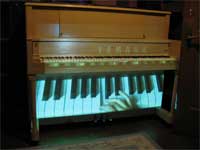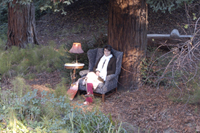Soft Loud
“Soft Loud” is an exploitation of the phenomenon of repetition revealing variation and as it happens - unexpected beauty.
The pianos represented in this piece are 19 of the pianos in the practice rooms in the Mills Music Department. Each piano was filmed in its natural environment a practice room with its own particular signature. The notes played on the piano are most often middle C, sometimes one of five other possible notes.Incidental to stalking and filming the pianos, I was delighted to notice - and be able to document the great many approaches musicians have to making their practice room space a living space. The keen observer will notice these details lurking in the nether regions of the installation space.
Thanks to Jean Klimack, David Kwan, Tara Rodgers and Nathalie Senécal for their assistance and feedback.
Swarm
Swarm attempts to draw attention to the fact that as humans we are nature. In order to subvert the paradigm which suggests that human beings are somehow separate from the world we live in, Swarm figuratively places the participant in the midst of a flock of birds. The work underscores this ambivalent relationship by proffering a technological surrogate for the human/animal dynamic. A movement-sensing camera tracks the position of a participant in the piece. As the participant navigates the installation space, audio and visual elements create the illusion that the participant is the lead in a flock of birds. Accompanied by the sound of flying birds, bright spots of light on the floor follow the participant in a pattern that mimics flocking behaviour.
Audio Caisson
Audio Caisson is a 9ft diameter geodesic dome, its walls and ceiling internally fitted with six speakers. A subwoofer and two tactile transducers are mounted in its floor. This domed space serves as a 360 degree, 3 dimensional, surround-sound environment. It is fed audio signals from a small geodesic-shaped, ambisonic, multi-microphone sculpture that is placed at least 100 ft away from the larger dome ideally in an acoustic space distinct from the one the dome inhabits. Audio signal is transferred from the microphone to the caisson - either by cable or short range FM transmitter.
Audio Caisson is a submersive environment intended to place the participant into an intimate relationship with sounds. Evoking our submersion in the every day soundscape that enfolds us, Audio Caisson attempts to place the participant in a direct relationship with sounds piped into its enclosed environment like air into a caisson. The experience challenges out habitual tendency towards sensory and mental removal from our audio environment.
The experience of interfacing with Audio Caisson challenges our habitual tendency towards sensory and mental removal from our audio environment by our preference for insulated interior spaces or the use of schizophonic sound in the form of iPods or simply over-active thoughts. The Caisson seems to offer an interior space that promises sonic isolation, an illusion that is enhanced by the memorative associations of the participant. By means of electronic chicanery, the Caisson instead provides an extremely active acoustic listening situation that is physically contained and acoustically open. Thus the Audio Caisson surprises the participant and places them in a state of vulnerability that leaves them more open and curious about the soundscape represented inside the piece.
The experience of Audio Caisson can be passive a place to listen to sounds without interference from visual distraction, or active with the participation of at least two people; one to perform sounds outside around the small microphonic version of the caisson, the other to listen inside the caisson.
As it happens, the piece is highly interactive. The sounds inside the caisson are created by participants as they make sounds around the microphone that feeds audio to the speakers inside the caisson. Physical gestures made with sound making objects like sea shells, rocks, pine cones and other items placed at the microphone are heard immediately inside the piece. Musical or sonic gestures that encircle the microphone are directly experienced by participants inside the artwork as sounds that encircle them.
Amplified Brook
The piece Amplified Brook used the setting of a displaced living room situated at the base of a redwood tree on the bank of Leona Creek a short stretch of un-landscaped moving water in the middle of Oakland California as a way of providing an opportunity to connect to the natural environment.
The participant was invited to simply listen to the sounds of the running water with the assistance of a mid-seventies stereo set and a pair of home made hydrophones immersed in the nearby stream. The comfort and familiarity of the living room placed as it was in the incongruous setting of this “natural” environment was intended to provide an extra attraction to potential participants. The implicit message in the superimposition of the interior built environment on the exterior natural environment is that we are still extremely close to our forest roots; that the extra effort of interfacing with the environment through listening (paying attention) is a matter of remembering our historical place of comfort in the natural world.

